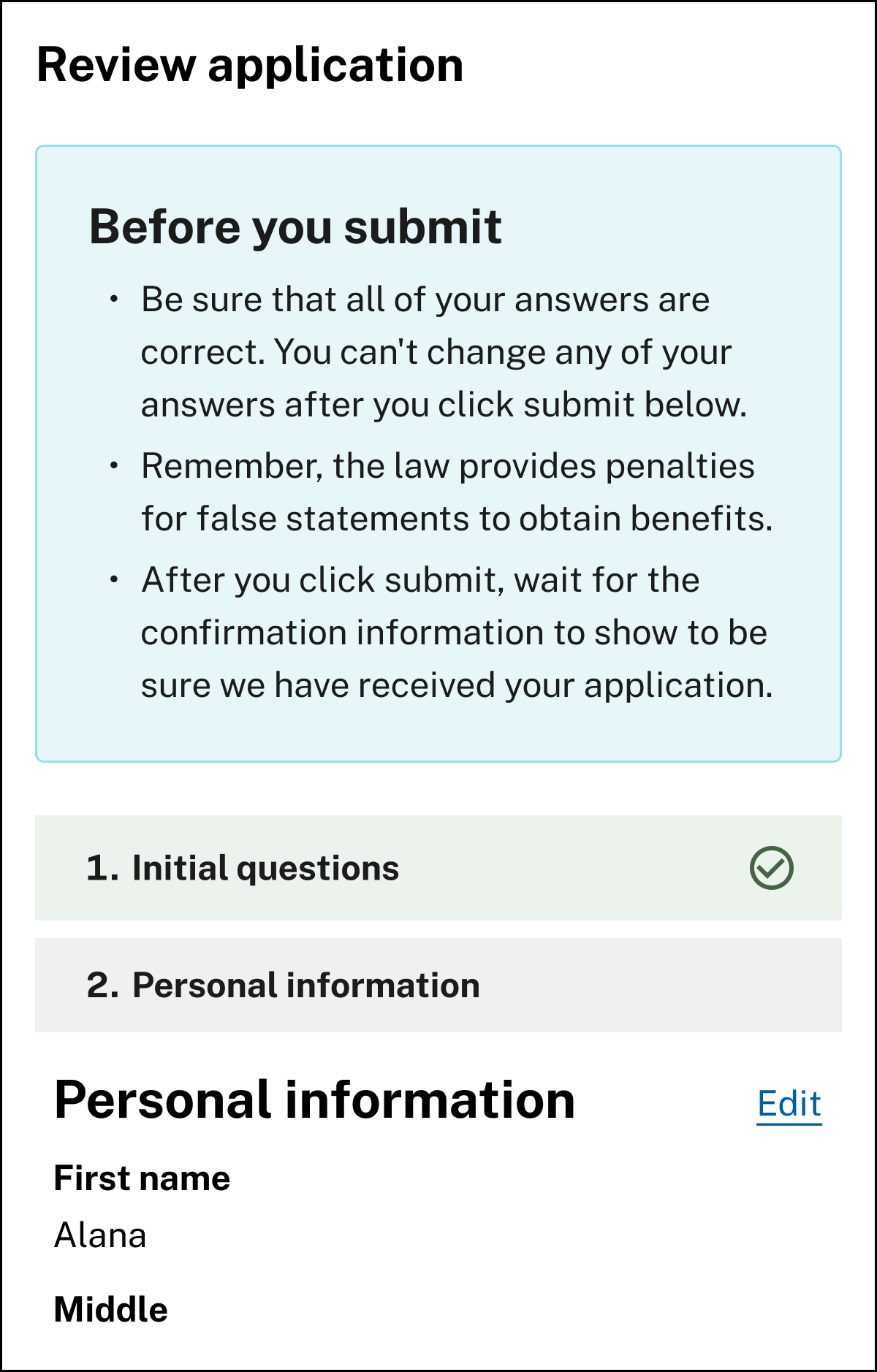Providing complete and accurate information on the initial application is one of the best ways individuals can ensure their UI claim will be processed properly and efficiently. After an individual completes the initial application, each state has different requirements as to what actions individuals need to take, including but not limited to, identity verification, document submission, fact finding, registering for reemployment services, and weekly certification tasks. If individuals are unaware of these requirements and don’t fulfill them, they could risk receiving improper payments or not receiving UI benefits they may be eligible for. Below are several recommendations that can help individuals accurately review the information they’ve provided and to understand what next steps they might need to take, such as responding to follow-up communication from the state or initiating weekly certification tasks.
Recommendation 1: Give individuals the opportunity to review their answers and make any needed corrections
Related CX principles: Use plain language, Provide contextual help
Providing incomplete or inaccurate information on the initial application can prove frustrating, and even costly, for some individuals, since incomplete or inaccurate information can lead to additional fact finding, delays in receiving benefits, or the need to file an appeal in certain cases. Below are interventions states can implement to help individuals submit error-free applications.
- Add an ‘Edit’ button that takes the individual directly to the section containing the response they want to modify. Refer to the example provided.
- Once they are satisfied with their responses, encourage individuals to print or email their responses to themselves, providing them with a record of what they have submitted.

Recommendation 2: Educate individuals on the subsequent steps in the process
Completing the initial UI application is likely the first step an individual will take in a lengthier process that includes substantial follow-up communication with the state agency. States can provide transparency into that process by communicating what individuals can expect in the weeks and months to come, including any actions they will need to take once their initial application has been submitted.
Outline what will happen next with the UI application
Related CX principle: Plain language
- Clearly explain expected next steps in the UI process using plain language. When possible, outline any additional actions an individual will need to complete to receive benefits.
- Add specific language so individuals are aware that submitting the initial application is just the beginning of the process. For example: “To receive unemployment insurance benefits, you will need to complete weekly certifications to determine your eligibility each week for which you wish to receive benefits.”
- Ask individuals how they prefer to receive communication from the state agency, for example by physical mail (U.S. Postal Service), by email, or by phone.
- Inform the individual in what formats they will receive additional follow-up information from the state agency, including notifications and alerts (e.g., by phone, email, or physical mail) so they can effectively monitor their incoming communication.
Communicate further actions an individual might need to take
Related CX principle: Plain language
If an UI claim has any outstanding issues that prevent an individual from receiving benefits they are eligible for, most individuals in that position would want to know what actions to take to resolve those issues. Clearly and promptly informing individuals on the actions necessary to resolve issues on their pending claims can help to alleviate potential confusion or concern. Here are some recommendations states can implement to provide further clarity into the process.
- Clearly state when individuals must start the process of certifying for weekly benefits since individuals are often unaware that they need to certify even while their initial application is still being processed.
- Inform individuals that as part of the certification process, they will need to answer eligibility questions, which may include certain work search requirements to determine their eligibility for benefits for each week.
- Provide information on work search or reemployment services, as appropriate, including any applicable registration links and contact information so individuals can readily access these services.
- Inform individuals that they may need to provide more information to the state, such as additional identification documents, work authorization documentation, and/or wage information.
Sample language for instructions
After you submit your application, we will determine if you qualify for benefits. To be eligible for benefits (in other words, to be able to receive a benefit payment) each week, you will need to meet weekly eligibility requirements. In order for us to determine that you meet these eligibility requirements each week, you will need to answer some additional questions [STATE INSERT WEEKLY OR BI-WEEKLY]. This process is also known as certifying for benefits [PLACEHOLDER FOR ADDITIONAL STATE-SPECIFIC INFORMATION ABOUT WHEN TO SUBMIT A CONTINUED CLAIM].
Recommendation 3: Support individuals’ needs for transparency and ongoing access to information by providing clear modes of communication
Related CX principle: Plain language
Some individuals will have specific questions about their UI claim or will require support when faced with an unforeseen issue. States should provide clear instructions for a range of scenarios, including when an individual encounters an obstacle in the initial application or certification process and can’t move forward.
- Provide information (such as a unique identifier) that individuals can use to identify themselves or their claim in the future. When an individual successfully submits their initial application, we recommend to not include a confirmation number if that confirmation number will not be used by the state agency to identify the individual or to retrieve an individual’s application information.
- List up-to-date contact information, including all claimant support channels (e.g., phone numbers, email addresses, website links, physical office locations) and applicable hours of operation so individuals know when and how to get in touch with the state agency through online means or where to go for in-person assistance.
